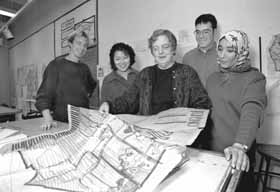
| ||
 | ||
 |
|
SYLVAIN COMEAU | McGill's School of Urban Planning is doing something a little unusual this year McGill's graduate program in urban planning The school became an autonomous division in 1972, and today exists as a unit within the Faculty of Engineering that continues to focus on graduate studies. Bland and Spense-Sales created the McGill program during a period in which there was growing concern about the way cities were developing. Overcrowding, poor sanitation, unsatisfactory roads Current director Jeanne Wolfe says that one of the most remarkable aspects of the school is that she is only the third director in its history. "You could say that we risk getting stuck in a rut," says Wolfe, who was named the director in 1988. "But I think it gives the school an extraordinary continuity, which is enhanced by the fact that many graduates come back to teach a course, or take a student for a summer internship." Canada's first-ever female municipal planner was a graduate of the program, as is the current head of urban planning for Montreal. Other graduates are policymakers and advisers at Public Works Canada, the Canadian Mortgage and Housing Corporation and the Ontario Environmental Assessment Board. The head of McGill's own Planning Office, Chuck Adler, is an alumnus. The school has witnessed many transformations during its 25 years. Wolfe says technology has had the most profound influence. "We gave our first courses in desktop computing in 1982; since then, we are using Graphical Information Systems (GIS), which is interactive computer mapping. That allows for the simultaneous testing of variables, such as the density of human settlements in a certain area, and the provision of infrastructure in response to population demand." More recently, students have begun learning how to use Softimage Another unmistakable shift has been an increasing emphasis on ecological concerns and sustainable development. "For instance, the biggest deposit in landfill sites is disused building materials, so there is a much greater emphasis in the planning stages on the use of recyclable materials," says Wolfe. One example of the school's growing ecological expertise is the Éco-Montréal project. Students from the school joined forces with the Montreal Sustainable Development Association to create a comprehensive "green map" of the city. The map focuses on a wide range of environmental "plusses" like bike paths, farmers' markets, community gardens and bird sanctuaries, as well as less savoury environmental elements such as landfills and toxic waste sites. The Biosphere has expressed an interest in exhibiting the map, which is also available on the Internet (ww2.mcgill.ca/sup/ecomon/ecomap.htm). Wolfe says urban planners in the 1990s need to have some talent for diplomacy. "That's because planners now engage in much more negotiation, dispute resolution and consultations with the population. They may get involved in disputes between developers and municipal councils, or they may have to help launch consultations on social issues, such as the development of services for groups like migrants or the elderly." The program attracts students from a variety of academic backgrounds. Students hail from geography, architecture, engineering, political science, sociology The demand for urban planners in this city isn't very strong, warrants Wolfe. "There isn't much work in Montreal and that's a problem." But there are jobs further afield. Many recent graduates have profited from the school's increasing international involvements (the school recently helped set up a graduate planning program at the University of the West Indies, for instance, and is active in several CIDA projects) to land contracts in other countries. Several graduates have also found work in the U.S. Wolfe credits this to two factors "We have alumni working in Washington, Oregon and Minnesota. Some [American] cities have become so rundown, they have no choice but to address this." Wolfe says there is "a strong dose of idealism" in her profession. "All urban planners must predict and plan for the future; this is what separates planning from geography, sociology, economics, or any other of the analytical fields. Planners have a great belief that the future can be an improvement."
|
|
| |||||